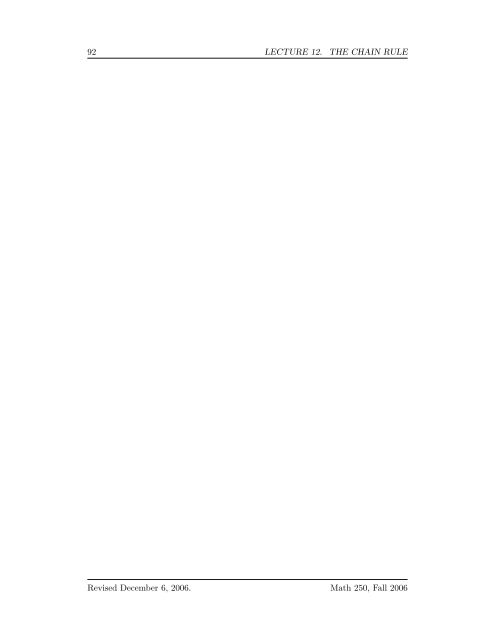Multivariate Calculus - Bruce E. Shapiro
Multivariate Calculus - Bruce E. Shapiro Multivariate Calculus - Bruce E. Shapiro
92 LECTURE 12. THE CHAIN RULE Revised December 6, 2006. Math 250, Fall 2006
Lecture 13 Tangent Planes Since the gradient vector is perpendicular to a surface in three dimensions, we can find the tangent plane by constructing the locus of all points perpendicular to the gradient vector. In fact, we will define the tangent plane in terms of the gradient vector. Definition 13.1 The tangent plane to a surface f(x, y, z) = k at a point P 0 = (x 0 , y 0 , z 0 ) is the plane perpendicular to the gradient vector at p 0 . To get a formula for the tangent plane, let P = (x, y, z) run over all points in the plane. Then any vector of the form P − P 0 = (x − x 0 , y − y 0 , z − z 0 ) = (x − x 0 )i + (y − y 0 )j + (z − z 0 )k Since ∇f(x 0 , y 0 , z 0 ) is normal to the tangent plane, the critical equation defining the tangent plane is (P − P 0 ) · ∇f(x 0 , y 0 , z 0 ) = 0 (13.1) Example 13.1 Find the equation of the plane tangent to the surface at the point P 0 = (1, 2, 3). 3x 2 + y 2 − z 2 = −20 Solution. First, we rewrite the equation of the surface into the form f(x, y, z) = 0, as f(x, y, z) = 3x 2 + y 2 − z 2 + 20 = 0 The general form of the gradient vector at any point on the surface is then ∇f = ∂f ∂x i + ∂f ∂y j + ∂f ∂z At the point P 0 = (1, 2, 3) the gradient is k = 6xi + 2yj − 2zk ∇f(P 0 ) = 6(1)i + 2(2)j − 2(3)k = 6i + 4j − 6k 93
- Page 53 and 54: LECTURE 5. VELOCITY, ACCELERATION,
- Page 55 and 56: LECTURE 5. VELOCITY, ACCELERATION,
- Page 57 and 58: Lecture 6 Surfaces in 3D The text f
- Page 59 and 60: Lecture 7 Cylindrical and Spherical
- Page 61 and 62: LECTURE 7. CYLINDRICAL AND SPHERICA
- Page 63 and 64: Lecture 8 Functions of Two Variable
- Page 65 and 66: LECTURE 8. FUNCTIONS OF TWO VARIABL
- Page 67 and 68: LECTURE 8. FUNCTIONS OF TWO VARIABL
- Page 69 and 70: LECTURE 8. FUNCTIONS OF TWO VARIABL
- Page 71 and 72: Lecture 9 The Partial Derivative De
- Page 73 and 74: LECTURE 9. THE PARTIAL DERIVATIVE 6
- Page 75 and 76: LECTURE 9. THE PARTIAL DERIVATIVE 6
- Page 77 and 78: LECTURE 9. THE PARTIAL DERIVATIVE 6
- Page 79 and 80: Lecture 10 Limits and Continuity In
- Page 81 and 82: LECTURE 10. LIMITS AND CONTINUITY 6
- Page 83 and 84: LECTURE 10. LIMITS AND CONTINUITY 7
- Page 85 and 86: Lecture 11 Gradients and the Direct
- Page 87 and 88: LECTURE 11. GRADIENTS AND THE DIREC
- Page 89 and 90: LECTURE 11. GRADIENTS AND THE DIREC
- Page 91 and 92: LECTURE 11. GRADIENTS AND THE DIREC
- Page 93 and 94: Lecture 12 The Chain Rule Recall th
- Page 95 and 96: LECTURE 12. THE CHAIN RULE 83 The p
- Page 97 and 98: LECTURE 12. THE CHAIN RULE 85 Examp
- Page 99 and 100: LECTURE 12. THE CHAIN RULE 87 becau
- Page 101 and 102: LECTURE 12. THE CHAIN RULE 89 Solut
- Page 103: LECTURE 12. THE CHAIN RULE 91 Examp
- Page 107 and 108: LECTURE 13. TANGENT PLANES 95 Solut
- Page 109 and 110: LECTURE 13. TANGENT PLANES 97 Multi
- Page 111 and 112: LECTURE 13. TANGENT PLANES 99 Accor
- Page 113 and 114: Lecture 14 Unconstrained Optimizati
- Page 115 and 116: LECTURE 14. UNCONSTRAINED OPTIMIZAT
- Page 117 and 118: LECTURE 14. UNCONSTRAINED OPTIMIZAT
- Page 119 and 120: LECTURE 14. UNCONSTRAINED OPTIMIZAT
- Page 121 and 122: LECTURE 14. UNCONSTRAINED OPTIMIZAT
- Page 123 and 124: LECTURE 14. UNCONSTRAINED OPTIMIZAT
- Page 125 and 126: LECTURE 14. UNCONSTRAINED OPTIMIZAT
- Page 127 and 128: LECTURE 14. UNCONSTRAINED OPTIMIZAT
- Page 129 and 130: Lecture 15 Constrained Optimization
- Page 131 and 132: LECTURE 15. CONSTRAINED OPTIMIZATIO
- Page 133 and 134: LECTURE 15. CONSTRAINED OPTIMIZATIO
- Page 135 and 136: LECTURE 15. CONSTRAINED OPTIMIZATIO
- Page 137 and 138: LECTURE 15. CONSTRAINED OPTIMIZATIO
- Page 139 and 140: Lecture 16 Double Integrals over Re
- Page 141 and 142: LECTURE 16. DOUBLE INTEGRALS OVER R
- Page 143 and 144: LECTURE 16. DOUBLE INTEGRALS OVER R
- Page 145 and 146: LECTURE 16. DOUBLE INTEGRALS OVER R
- Page 147 and 148: Lecture 17 Double Integrals over Ge
- Page 149 and 150: LECTURE 17. DOUBLE INTEGRALS OVER G
- Page 151 and 152: LECTURE 17. DOUBLE INTEGRALS OVER G
- Page 153 and 154: LECTURE 17. DOUBLE INTEGRALS OVER G
92 LECTURE 12. THE CHAIN RULE<br />
Revised December 6, 2006. Math 250, Fall 2006



